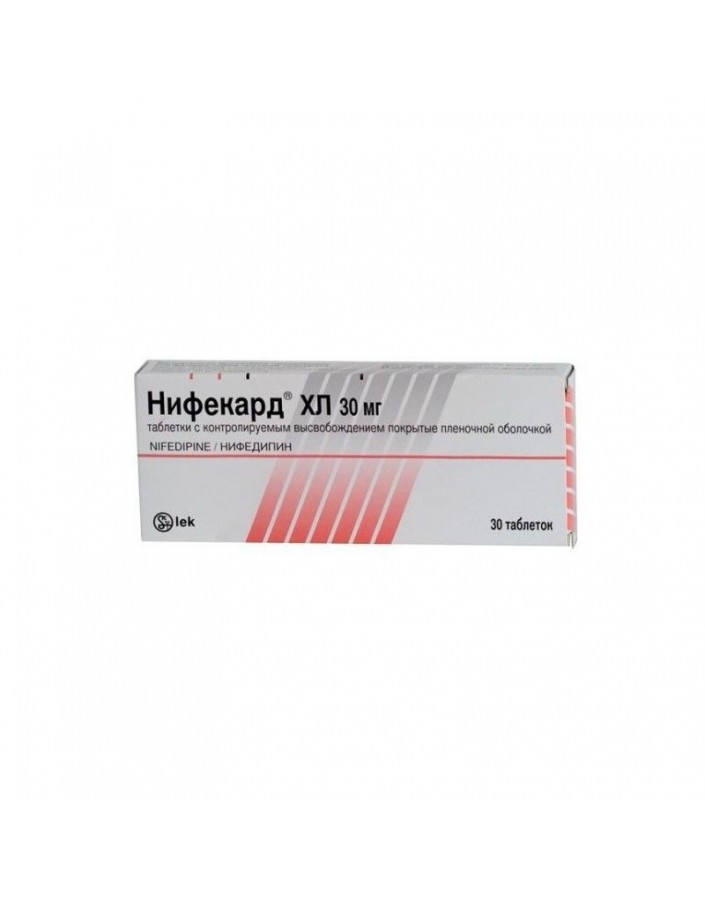




Security policy (edit with Customer reassurance module)

Delivery policy (edit with Customer reassurance module)

Return policy (edit with Customer reassurance module)
Controlled release tablets
Each pill contains 30 mg of Nifedipine
30 pieces
Nifecard CL is a selective BMCC, a derivative of 1,4-dihydropyridine. It has a vasodilating, antianginal and hypotensive effect. Reduces the current of CA 2+ in cardiomyocytes and smooth muscle cells of the coronary and peripheral arteries; in high doses, inhibits the release of Ca 2+ from intracellular depots. Reduces the number of functioning channels without affecting the time of their activation, inactivation and recovery.
Separates the processes of excitation and contraction in the myocardium, mediated by tropomyosin and troponin, and in vascular smooth muscle, mediated by calmodulin. In therapeutic doses, it normalizes the transmembrane current of Ca 2+, which is disturbed in a number of pathological conditions, first of all, in arterial hypertension. Does not affect the tone of the veins. Enhances coronary blood flow, improves blood supply to the ischemic zones of the myocardium without developing the “robbery” phenomenon, activates the functioning of collaterals. Expanding the peripheral arteries, decreases the round neck, myocardial tone, afterload,myocardial need for oxygen and increases the duration of LV diastolic relaxation. Virtually no effect on SA and AV nodes and does not possess antiarrhythmic activity. Strengthens a renal blood-groove, causes a moderate natriuresis.
Arterial hypertension, ischemic heart disease: stable angina pectoris, vasospastic angina pectoris.
Hypotension, severe aortic valve stenosis, obstructive cardiomyopathy, pregnancy and breastfeeding, hypersensitivity to nifedipine.
Nifecard XL is prescribed individually. The initial dose of the drug is 30 or 60 mg per day once. pills should be taken without chewing, you can not crush them or divide.
Selection of the dose is carried out gradually, at intervals of 7-14 days.
The maximum daily dose is 90 mg.
With the necessary withdrawal of the drug, the dosage is gradually reduced to a complete abolition.
Of the side effects of the drug are most often found: headache, redness of the skin, dizziness, nausea, weakness, peripheral edema. In some cases, you may experience chest pain after taking the drug.
There are separate reports of the occurrence of such side effects as: drowsiness, hypotension, syncope, palpitations, decompensated heart failure, hyperplasia, convulsions of the upper and lower extremities, and diarrhea.
not prescribed for cardiogenic shock with residual angina (risk of myocardial infarction). Caution is prescribed to patients with congestive heart failure, abnormal liver function and diabetes.
For patients with severe coronary artery disease, there is a risk of an increase in the frequency, severity of manifestations and duration of strokes after taking nifedipine. In this case, the abolition of the drug. There are no data on the safety of using nifedipine during pregnancy, therefore, the prescription of nifedipine to pregnant women is justified only when the possible effect of taking the drug outweighs the possible risk to the fetus.
Nifedipine passes into breast milk, so the drug is not prescribed during lactation.
Due to the synergistic effect, caution is necessary with the simultaneous use of nifedipine and other antihypertensive agents, beta-blockers and nitrates. The simultaneous appointment of nifedipine and Digoxin increases plasma concentrations of nifedipine, therefore, control of plasma concentrations of digoxin and, if necessary, dose adjustment of digoxin is necessary. Nifedipine reduces the metabolism of phenytoin, whereas the simultaneous administration of nifedipine with cyclosporine or cimetidine may cause an increase in the level of nifedipine in the blood. Simultaneous administration of nifedipine and fentanyl can cause severe hypotension, therefore, it is recommended that nifedipine be removed at least 36 hours before anesthesia (if possible). In patients taking nifedipine, plasma concentrations of quinidine can be reduced by 50%. Nifedipine causes an increase in theophylline level in the blood while it is administered simultaneously.
An overdose of nifedipine causes peripheral vasodilation with severe and possibly prolonged systemic hypotension.
Treatment of overdose is to remove the drug from the body and carefully monitor vital functions, heart activity, lung and excretory system. The clearance of nifedipine is increased in patients with liver failure. Due to the high degree of binding to plasma proteins, hemodialysis is not effective.
Store at a temperature not higher than 25 C.